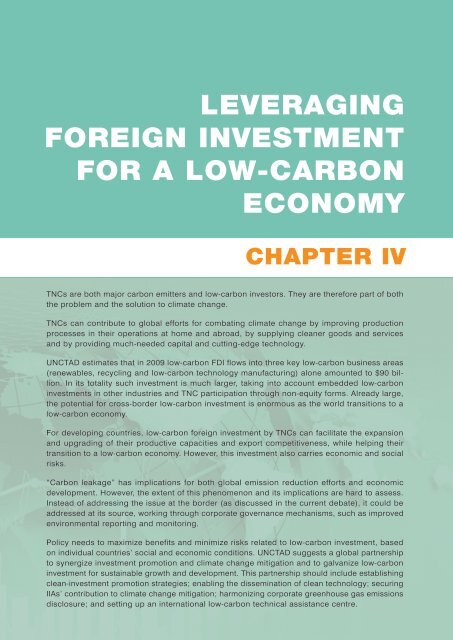UN World Investment Report 2010 - Office of Trade Negotiations
UN World Investment Report 2010 - Office of Trade Negotiations
UN World Investment Report 2010 - Office of Trade Negotiations
You also want an ePaper? Increase the reach of your titles
YUMPU automatically turns print PDFs into web optimized ePapers that Google loves.
LEvERAGING<br />
FOREIGN INvESTMENT<br />
FOR A LOW-CARBON<br />
ECONOMY<br />
CHAPTER Iv<br />
TNCs are both major carbon emitters and low-carbon investors. They are therefore part <strong>of</strong> both<br />
the problem and the solution to climate change.<br />
TNCs can contribute to global efforts for combating climate change by improving production<br />
processes in their operations at home and abroad, by supplying cleaner goods and services<br />
and by providing much-needed capital and cutting-edge technology.<br />
<strong>UN</strong>CTAD estimates that in 2009 low-carbon FDI flows into three key low-carbon business areas<br />
(renewables, recycling and low-carbon technology manufacturing) alone amounted to $90 billion.<br />
In its totality such investment is much larger, taking into account embedded low-carbon<br />
investments in other industries and TNC participation through non-equity forms. Already large,<br />
the potential for cross-border low-carbon investment is enormous as the world transitions to a<br />
low-carbon economy.<br />
For developing countries, low-carbon foreign investment by TNCs can facilitate the expansion<br />
and upgrading <strong>of</strong> their productive capacities and export competitiveness, while helping their<br />
transition to a low-carbon economy. However, this investment also carries economic and social<br />
risks.<br />
“Carbon leakage” has implications for both global emission reduction efforts and economic<br />
development. However, the extent <strong>of</strong> this phenomenon and its implications are hard to assess.<br />
Instead <strong>of</strong> addressing the issue at the border (as discussed in the current debate), it could be<br />
addressed at its source, working through corporate governance mechanisms, such as improved<br />
environmental reporting and monitoring.<br />
Policy needs to maximize benefits and minimize risks related to low-carbon investment, based<br />
on individual countries’ social and economic conditions. <strong>UN</strong>CTAD suggests a global partnership<br />
to synergize investment promotion and climate change mitigation and to galvanize low-carbon<br />
investment for sustainable growth and development. This partnership should include establishing<br />
clean-investment promotion strategies; enabling the dissemination <strong>of</strong> clean technology; securing<br />
IIAs’ contribution to climate change mitigation; harmonizing corporate greenhouse gas emissions<br />
disclosure; and setting up an international low-carbon technical assistance centre.

















